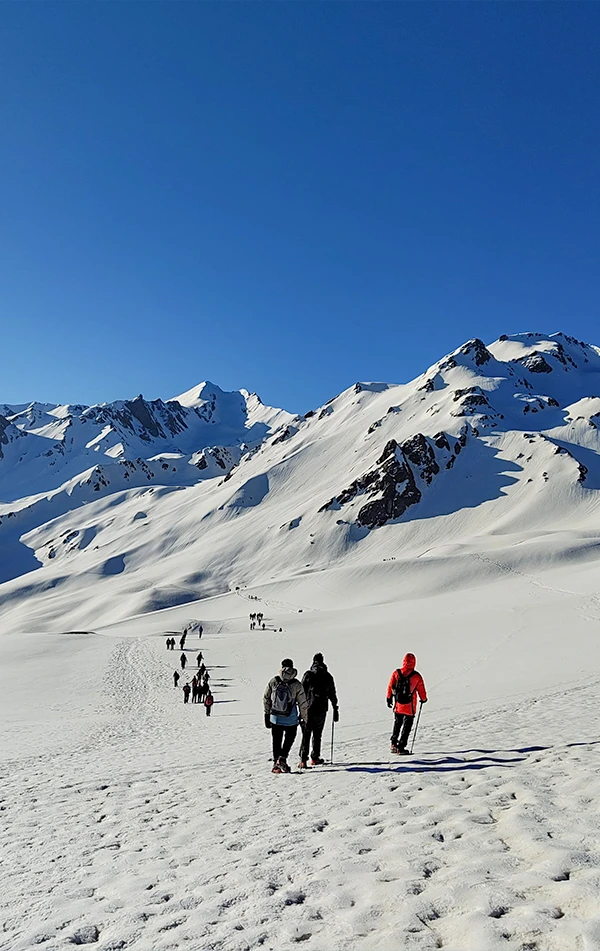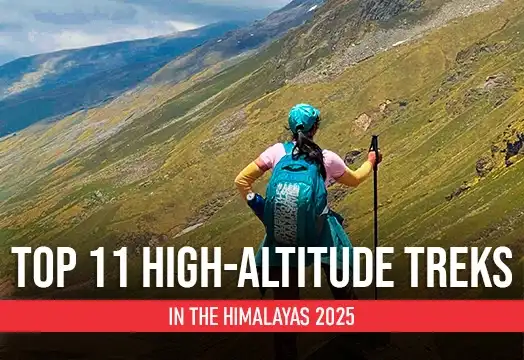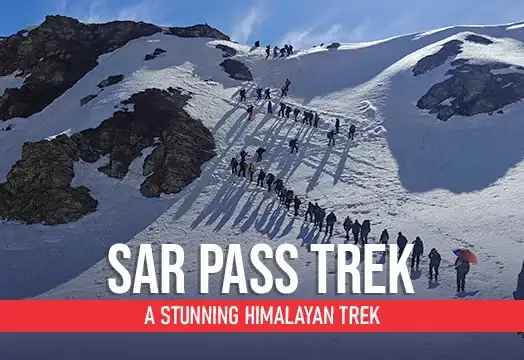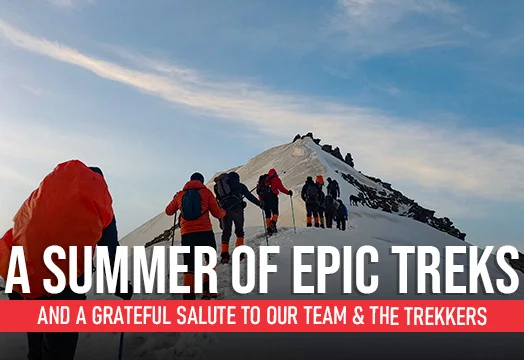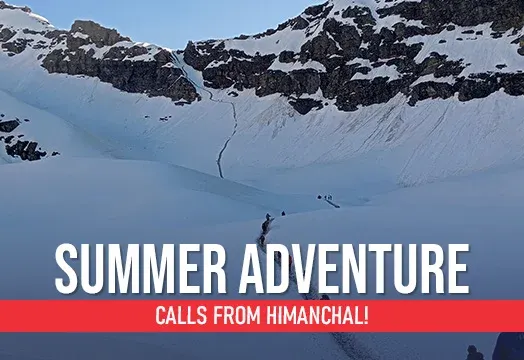Sar Pass Trek

Region
Himachal Pradesh | India

Duration
5 Days

Max Altitude
13600 Ft.

Trekking Km
33 KM

Grade
Moderate
Get in Touch with Our Trek Expert
91 7302321133 info@trekthehimalayas.comMonday - Saturday: 10 AM to 09.30 PM (GMT +5:30)
Sunday: 10 AM to 05.30 PM (GMT +5:30)
11300 /Person
- May-2026
- June-2026
- Services from Grahan Village to Barshaini
- Pickup & Drop Location:
Wonder Wood Camp Kasol Teh. Bhunter Distt. Kullu (HP), 175105 Kasol, India.
Pickup: 11:00 AM | Drop: 06:30 PM–07:30 PM (weather/road dependent)
Keep a buffer day and arrive a day early to avoid delays. - Base Camp Accommodation: Home stay with attached washroom (no bunk beds).
- Complimentary cloakroom at base camp for safe storage.
- Avail Special Casual Leave if you’re a Central Govt. employee.
- Trek again for free
Add-ons
Insurance 200
- Insurance is mandatory.
- It is available for Indian citizens only.
- Non-Indians have to take insurance on their own.
- If you already have the high altitude trekking insurance, email for a refund after booking.
- The cancellation policy will be implemented in accordance with the trek cancellation policy.
- For more details about insuranceclick here
- + 5% GST will be applicable
Transport 1500
- Transportation from Kasol to Kasol & return is optional.
- Choose add-ons during booking. If missed, log in and add them later.
- Book transportation at least 10 days before the trek.
- Cancellation 4 or more days before the start of the trip results in a 100% cash refund.
- Cancellation less than 4 days from the start of the trip results in a 50% cash refund.
- Cancellations made on the trip date are not eligible for a refund.
- + 5% GST will be applicable
Offload 4800
- Backpack offload is optional.
- Choose add-ons during booking. If missed, log in and add them later.
- Book off-load at least 10 days before the trek.
- For offline bookings at the base camp, a convenience fee of Rs. 5500 applies.
- Cancellations made before the trip date will receive a full refund.
- + 5% GST will be applicable
Single Occupancy Tent 3000
- Single Occupancy Tent is optional.
- Choose add-ons during booking. If missed, log in and add them later.
- Book Single Occupancy Tent at least 10 days before the trek.
- Cancellations made before the trip date will receive a full refund.
- + 5% GST will be applicable
Get in Touch with Our Trek Expert
91 7302321133info@trekthehimalayas.com
Monday - Saturday: 10 AM to 06 PM (GMT +5:30)
Overview
Trek Name: Sar Pass Trek
Days: 5
Adventure Type: Trekking
Base Camp: Kasol
Season:Summer |
Month:May | June |
Country: India
Altitude: 13600 Ft.
Grade: Moderate
Rail Head: Chandigarh is the nearest rail head to the base camp
Stay: Camping (Twin sharing) & Home Stay (Separate for male & Female)
Food: Meals while on trek & at Hotel/Guesthouse (Veg & Eggs)
Location: Himachal Pradesh
Distance: 33 Km.
Trail Type: Cross over trail | Start in one valley, traverse the pass, and ends in another valley.
AirPort: Bhuntar, which is 52 km away from Manali
Highlights:
- Services from Grahan Village to Barshaini
- Pickup & Drop Location:
Wonder Wood Camp Kasol Teh. Bhunter Distt. Kullu (HP), 175105 Kasol, India.
Pickup: 11:00 AM | Drop: 06:30 PM–07:30 PM (weather/road dependent)
Keep a buffer day and arrive a day early to avoid delays. - Base Camp Accommodation: Home stay with attached washroom (no bunk beds).
- Complimentary cloakroom at base camp for safe storage.
- Avail Special Casual Leave if you’re a Central Govt. employee.
- Trek again for free
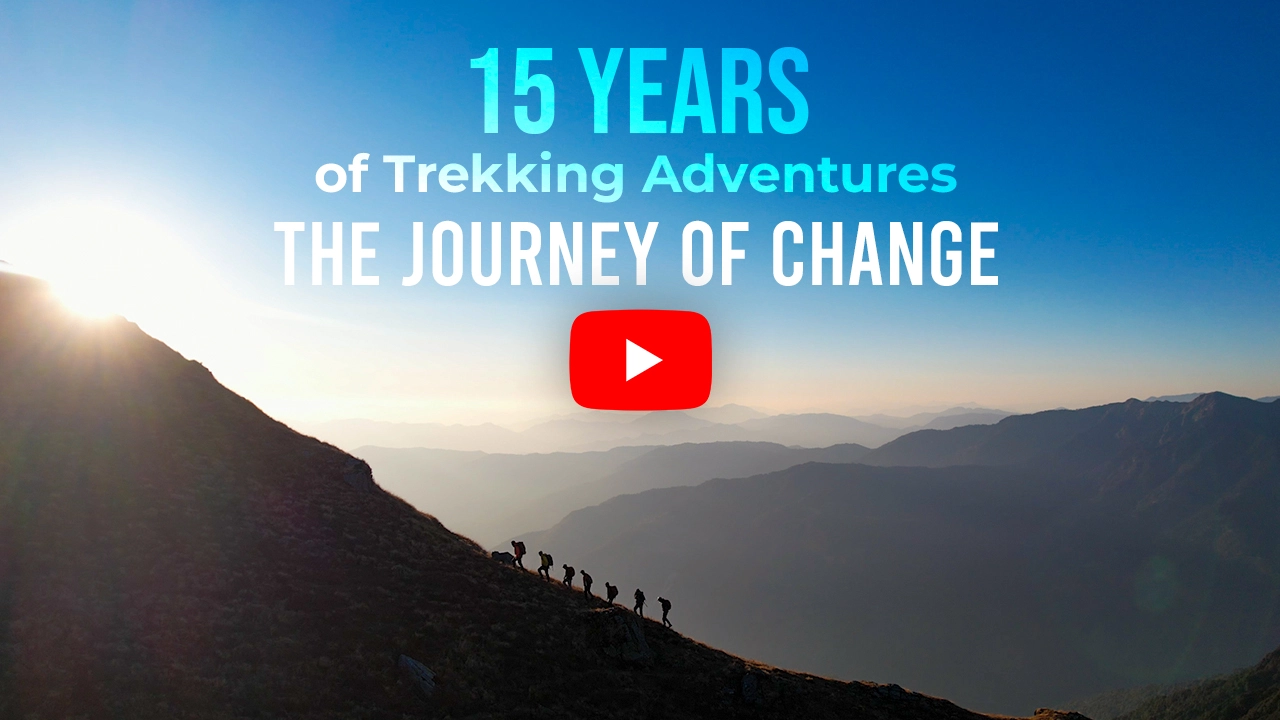
Why is Sar Pass a Must-Do Trek?
- Sar Pass Trek has some of the most stunning views in the Indian Himalayas, from lush meadows to snow-covered peaks, every turn presents a new visual delight, making it a picturesque paradise for you.
- The Sar Pass, being at an impressive altitude, provides a jaw-dropping panoramic view of the surrounding mountains and valleys. Standing at the pass, amid the vast meadows you get a sense of victory and awe at the vastness of nature.
- The trail takes you through an impressive mix of landscapes, dense forests, alpine meadows, rocky terrain, and snow-covered paths.
- Trekking here allows you to witness diverse plant life, rare herbs, and wildlife like the Himalayan tahr, langurs, and various species of birds.
- Along the route, you’ll pass through picturesque locations like Grahan and Kasol. These places are rich in culture and offer a glimpse into the local way of life, with wooden houses, fields, and friendly locals who often share stories of the region.
- The silence of the mountains, the fresh air, and the serenity of the landscape bring a sense of calm, making the trek as much about inner growth as it is about exploring nature.
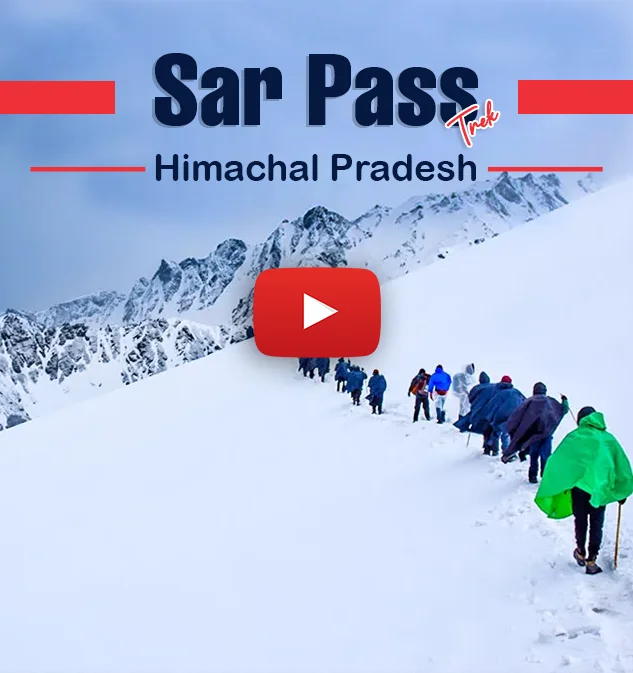
Who Can Participate
- Age Requirement:
- Minimum 12 years
- First-timers are welcome, though prior trekking experience is preferred. Good fitness is a must.
- Fitness Criteria:
- If the trekker wants to carry a backpack then he/she should be able to carry a 10-12 kg backpack. If opt Off-load option then the trekker should be able to carry 3-5 kg backpack.
- If a trekker's BMI is more or less than the normal range (18-28), please consult our Trek Coordinator before booking.
Loved it? Do it again for free!!!
At Trek The Himalayas, we understand that things don’t always go as planned. If you couldn’t complete your trek or just want to experience it once more, we’re giving you a wonderful opportunity – the chance to do the trek again without having to pay the trek fee again.
Pay a one-time fee to select your favourite trek, and you can repeat it as many times as you want within 5 years.

Terms and Conditions:
- The offer is valid for 5 years from the trek departure date.
- Participants are not required to pay the trek cost again, but they will need to cover transportation, insurance, and trek permit costs.
- This offer is non-transferable and is only applicable to TTH's limited fixed departures.
- The offer does not apply if the participant has received a refund, a voucher, or a transfer to another trek that has been used previously.
- The offer will be activated once the participant reaches the trek base camp.
- This is not an offer linked to any purchased package; rather, it is an initiative extended by TTH out of goodwill, without any cost to the trekkers.
- Trek The Himalayas reserves the right to cancel this offer at any time, in case of:
- Disobeying the safety regulations, trekking rules, or the code of conduct
- Black listing due to bad behavior, payment issues, or providing inaccurate information
- Anything that would damage the brand or reputation of TTH
- In order to rebook, just fill in our booking form online or call our team.
Sar Pass Trek Itinerary
Kasol To Grahan Village
- Altitude:
- Kasol: 1,700 m / 5,600 ft
- Grahan Stop: 2000 m / 6,500 ft
- Grahan Village: 2,350 m / 7,700 ft
- Drive Distance: 8 Km | 45 minutes
- Trek Distance: 2 Km | 1 hr
The Sar Pass Trek journey begins with an 8 km drive from the beautiful mountain village of Kasol to Grahan Stop, followed by a 2 km steep ascent to Grahan Village in Himachal Pradesh. Grahan Village is renowned for its enchanting evergreen forests and creeks, nestled beside the gushing Parvati River. Our trek leader and team will meet you in Kasol, where you'll have a brief introduction with teammates and receive instructions before embarking on the trek. The journey commences with an 8 km drive to Grahan Stop. Upon reaching the last road point at Grahan Stop, we'll commence the 2 km steep ascent to Grahan Village, our first-day campsite. The initial part of the trail passes through dense coniferous forests and the aroma of the pine trees will invade your senses as you walk through the forest.
After walking through the forested patch for some time, the forests will eventually give way to grasslands and you can see some local vendors with their tea stalls. These stalls also sell Rhododendron syrup, which is mixed with water to make a very refreshing drink. Grahan village is not very far. From here, it is about a steep climb of one hour before you enter the picturesque village setting.
Grahan is situated at the top of a hill and we will camp here for the night. Mobile coverage is sometimes available in Grahan but it is very erratic. The campsite is surrounded by Rhododendron trees making it look even more beautiful. After having a delicious lunch at the campsite, you can go about exploring the quaint village and its surroundings. The pleasantness of the scenery with the beautiful mountain views will captivate you. After a delectable dinner, you will retire to your tents ending the first day of trekking.
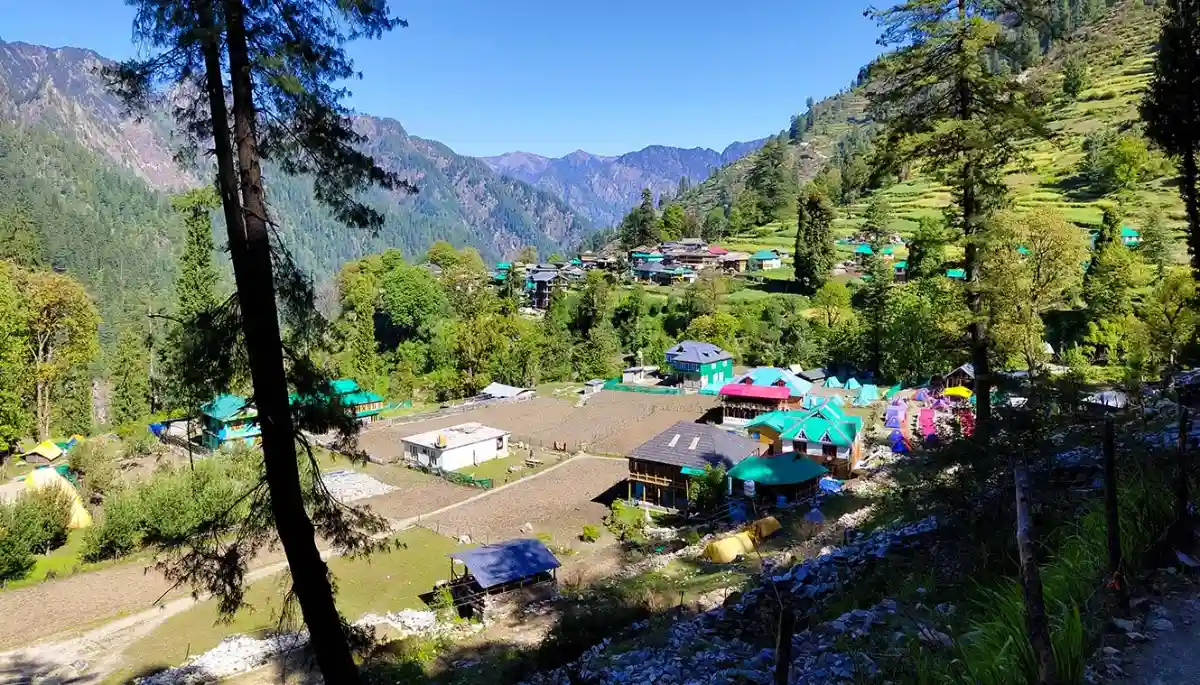
Grahan Village To Min Thach
- Altitude:
- Grahan Village: 2,350 m / 7,700 ft
- Min Thatch: 3,400 m / 11,150 ft
- Trek Distance: 8 km | 5-6 hrs.
Today we will trek to Min Thach, a beautiful meadow that falls en route to your trek. To reach Min Thach, we will follow the trail that goes north from our campsite at Grahan, this path will lead you to Min Thach. We will start our trek post a hearty breakfast at the Grahan campsite.
After walking for some time, wonderful mountain views begin to open up and the trail to Min Thach will be on your right. The climb to the meadow is a little steep and sometimes the trail becomes a little confusing, follow your trek leader’s instructions during these confusing patches. After walking for a few hours through the dense forests, it will open into a grassy ridge, this is Min Thach clearing and we will find a proper location here and pitch our tents for an overnight stay. Min Thach is usually used by locals to graze their cattle.
On the northwest side, you will get views of Chanderkhani and its adjoining mountain ranges stretching across the horizon. In the southeast, it is lined with dense evergreen forests. Sometimes there are also seasonal vendor stalls that sell tea, coffee, and the like. There’s also a water source in the form of a tap, and you will get potable water here. This is a good place to camp as the ridge protects the tents against strong winds. Also, having a day between Grahan and Nagaru campsite allows for the body to acclimatize well to the weather and the altitude. Sunset and sunrise views are especially beautiful here. Once you reach the campsite, relax and enjoy a beautiful sunset over the snow-clad mountains. After a hot dinner at the campsite, you will end the day and retire in your tents.
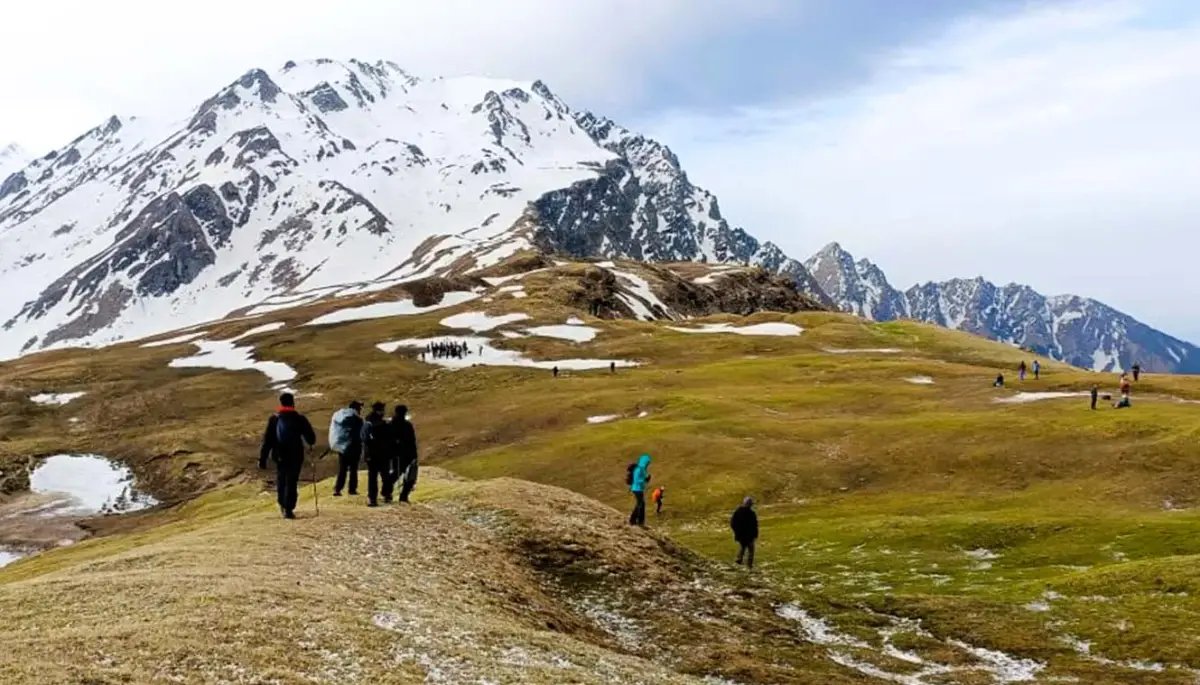
Min Thach To Nagaru
- Altitude:
- Min Thatch: 3,400 m / 11,150 ft
- Nagaru: 3,800 m / 12,400 ft
- Trek Distance: 5 km | 4-5 hrs
From Min Thach, you get glimpses of Nagaru and it doesn’t seem all that far but we are not going to take the straight ridge path to Nagaru, rather the trail entwines up towards the south and follows into the woods. Depending on the time you are visiting the trek, you may find patches of snow on the trail. It’s a good idea to start early as most of the time the weather remains favorable up until noon, post which it can be unpredictable. So, we will start out early today.
After walking some time through the forests, you will climb onto another ridge, this one is quite a bit rocky and overlooks the meadow down below. You have to take the left on the ridge, and it becomes pretty steep here. Nagaru sits atop a cliff that you have to ascend to reach the campsite. Follow the trail, it is pretty well marked here and after some time the tree line recedes and grassy patches begin to open up. If you are trekking in a season when there is snow on the trail then you have to be really careful as the snow can make the trek pretty tricky and slippery. Exercise extra caution and follow your guide’s instructions to avoid any mishap. Waterproof gloves and an ice axe can be helpful in these places.
After a couple of hours of trekking through varied terrains, you will arrive at a flatland on the top of a hill, this is Nagaru. As soon as you reach Nagaru, you will be totally amazed by the sight lying ahead of you. All of a sudden it seems like you have entered a different world from the one you have been trekking in so far! On the northern side, you can see the majestic mountains rising from the Parvati Valley down below. The Chanderkheni Ranges simply look magnificent and the Beas Valley with its greenery is amazing too. On your left, down below, you can see a bird’s eye view of Min Thach and Grahan village and to your south, you can see the vast expanse of snow up to the mountains. This is the direction you will trek in next to reach Sar Pass. The winds are very strong at Nagaru and the temperature drops pretty quickly so it is wise to set up the camps as soon as possible.
The nights here can be very chilly so have the appropriate layers on to protect yourself from the cold. After an early dinner, we will retire into the tents as the winds get stronger at night. Sleep well as tomorrow you will make your summit to Sar Pass.
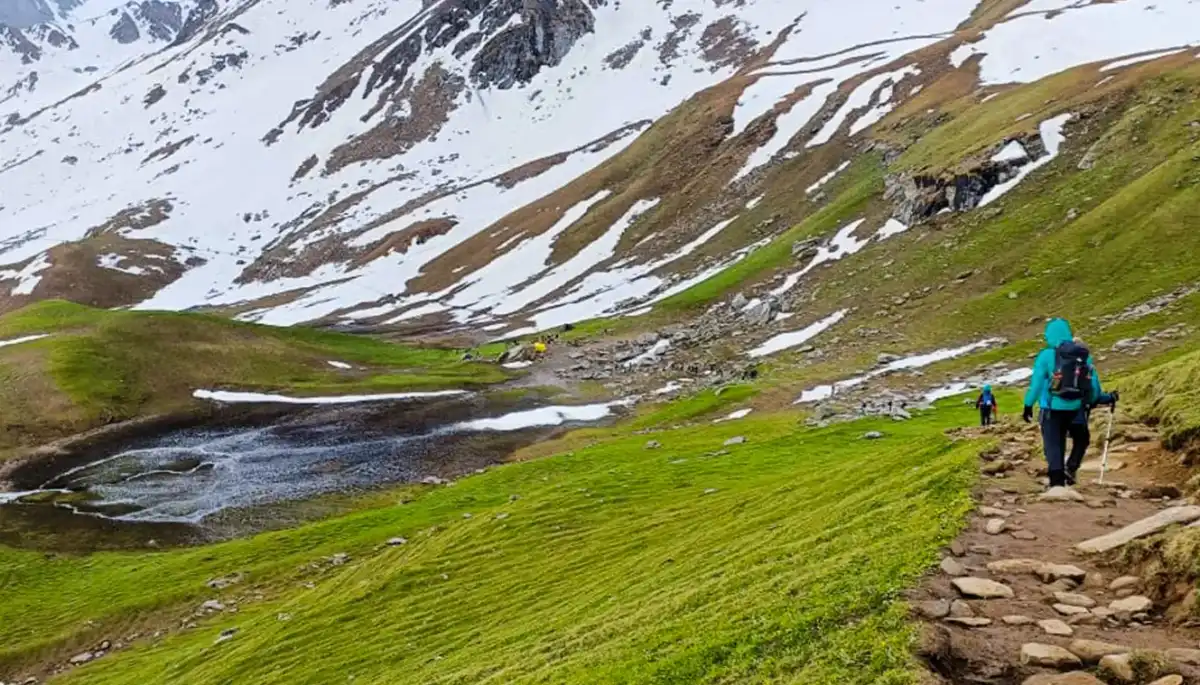
Nagaru To Biskeri Thach Via Sar Pass
- Altitude:
- Nagaru: 3,800 m / 12,400 ft
- Sar Pass: 4,200 m / 13,600 ft
- Biskeri Thach: 3,350 m / 11,000 ft
- Trek Distance: 12 km | 7-8 hrs
Today is an exciting day of trekking and also the longest trekking day. Today will head to Sar Pass! We will start the day early and wake up before dawn as we have a distance of 12 km to cover. The climb to the Pass is much like yesterday and you will use the same techniques. We will climb along the ridge line in a southward direction, there will be a couple of steep stretches that would test your physical and mental endurance. Keep a steady pace as you climb these stretches and cross the snow patches.
It is a bit easier to walk on the snow and the strikingly beautiful surroundings will take your tiredness away, and we are always there to motivate you along the way. From Nagaru, you can see a hill, and once you climb the hill another hill comes into view that we need to climb. The ridge becomes sharper and steeper and on one side the ridge falls steeply to the ridge below. Be very careful and cautious here. Crampons and ice axe will make walking on the snow easier.
Once you make it to the top of the hill after an arduous climb, you will forget all the struggles that you have faced because of the view lying in front of you. You have reached the summit at Sar Pass. You will observe a flag tied to a Trishul at the summit indicating that you have arrived at the summit. The pass has derived its name from ‘Sar’ meaning a ‘pond’ which lies at the top. The pond remains frozen till late summer. The beautiful peaks of the Tosh Valley greet you on the one the east and to the south, you can see snow-ensconced mountain peaks. There’s a sharp drop to a beautiful valley ahead of you, which you have to slide down as there is no other way to climb down. Soak in the heavenly beauty of the place before we slide down to the valley below.
The slide is harmless and really fun but also follow the team’s instructions to slide down properly. Keep all your loose materials in a bag and keep your legs tight together and do not dig into the snow. Also, keep your elbows firmly by the side and push your trunk back into the snow. The slide will take about a kilometer into a gentler slope in the valley and after walking for some time you will come across another slope though not as steep depending on the snow accumulated, you can choose to slide down once again till you reach level ground. Another slope will come not long after this. You can again cover this slope by sliding down. You will now reach a narrow valley with a beautiful meadow on the left, this is Biskeri Thach. There are a couple of stream crossings before you reach the meadows. This campsite presents the sublime beauty of pine forests and snow-covered mountains as the backdrop. There are lots of water streams beside the campsite, so you can refill your water here. There’s a water tap as well. You may even find network coverage for some networks as well. Tonight we will stay at Biskeri Thach and return to Kasol the following day.
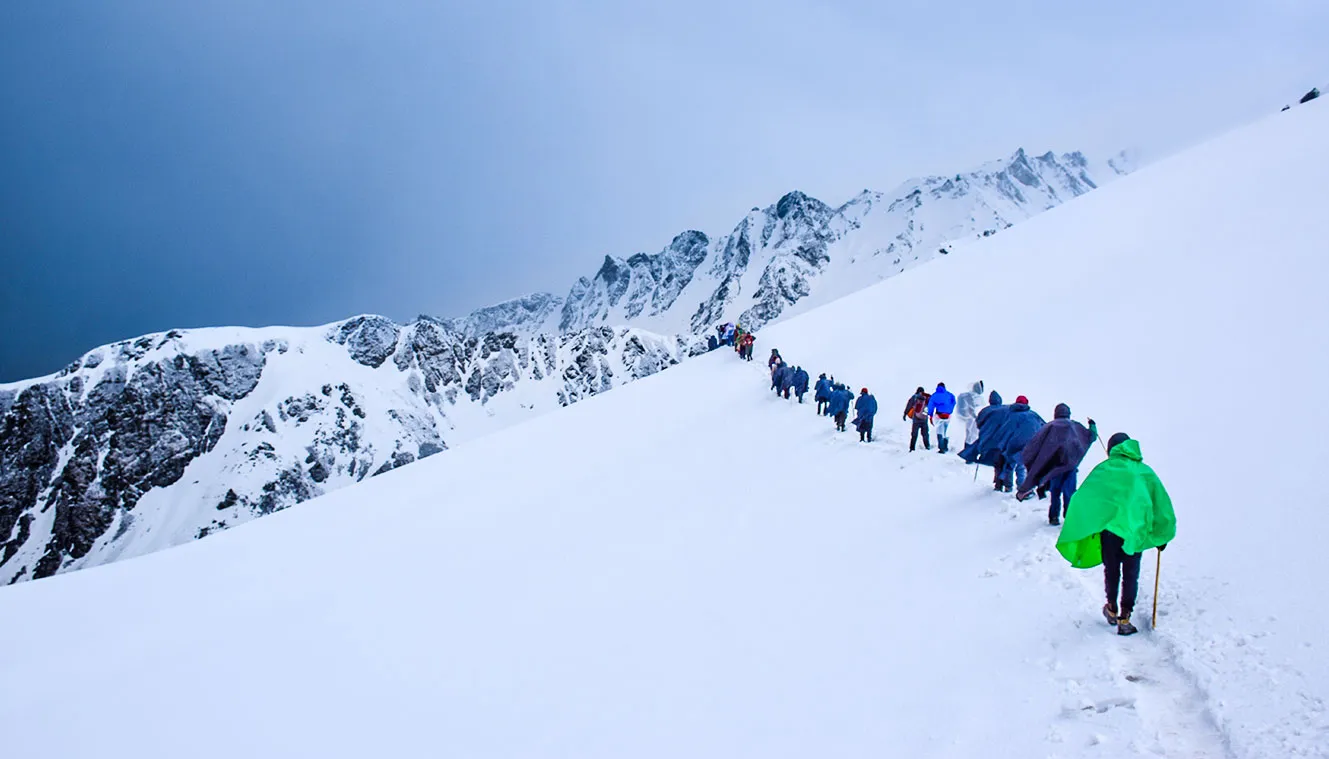
Biskeri Thach To Pulga And Drive Back To Kasol
- Altitude:
- Biskeri Thach: 3,350 m / 11,000 ft
- Pulga: 2,400 m / 7,800 ft
- Trek Distance: 6 km | 4-5 hrs
- Drive Distance: 18 km | 1 hr
Today is the last day of trekking in the mountains and also the last day of your wonderful journey to Sar Pass. Today is also a long walk and we have to cover a distance of 6 km downhill. From Biskeri Thach a steep path goes down below by the side of a stream. The trail ends at a fenced plot of land so you have to go through the land before you hop on the trail again.
Follow the trail and you will enter a dense forest, there are many trails here, follow the one that leads in the north-eastern direction. After walking through the forest for some time you will come across a stream crossing. You will then cross the stream on wooden planks laid across it and then climb up the path that leads to some campsites. The trail follows a water pipeline that takes you to Pulga village. Pulga and Tulga are twin villages that are separated by a stream. From Pulga you will drive back to Kasol. Kasol is about 18 km approximately from Barshaini and it takes about 45 minutes to 1 hr to reach Kasol depending on the road conditions. Thus ends this wonderful trek with so many beautiful memories for you to cherish forever.
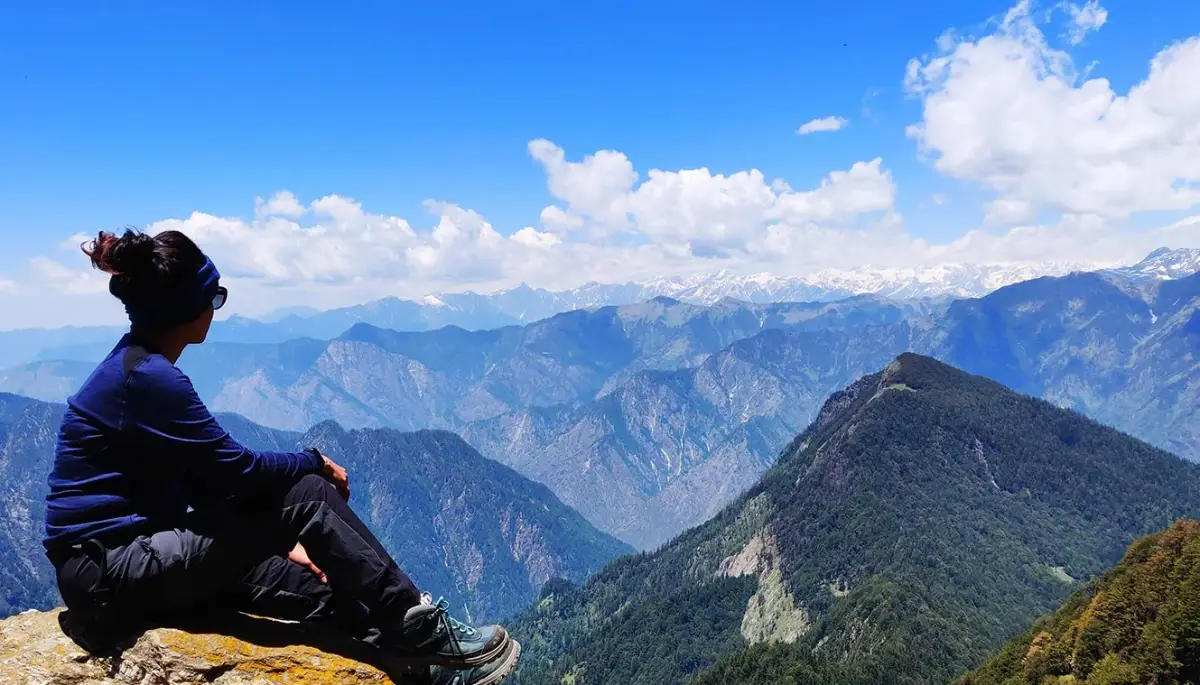
Day-1: Kasol To Grahan Village
- Altitude:
- Kasol: 1,700 m / 5,600 ft
- Grahan Stop: 2000 m / 6,500 ft
- Grahan Village: 2,350 m / 7,700 ft
- Drive Distance: 8 Km | 45 minutes
- Trek Distance: 2 Km | 1 hr
Day-2: Grahan Village To Min Thach
- Altitude:
- Grahan Village: 2,350 m / 7,700 ft
- Min Thatch: 3,400 m / 11,150 ft
- Trek Distance: 8 km | 5-6 hrs.
Day-3: Min Thach To Nagaru
- Altitude:
- Min Thatch: 3,400 m / 11,150 ft
- Nagaru: 3,800 m / 12,400 ft
- Trek Distance: 5 km | 4-5 hrs
Day-4: Nagaru To Biskeri Thach Via Sar Pass
- Altitude:
- Nagaru: 3,800 m / 12,400 ft
- Sar Pass: 4,200 m / 13,600 ft
- Biskeri Thach: 3,350 m / 11,000 ft
- Trek Distance: 12 km | 7-8 hrs
Day-5: Biskeri Thach To Pulga And Drive Back To Kasol
- Altitude:
- Biskeri Thach: 3,350 m / 11,000 ft
- Pulga: 2,400 m / 7,800 ft
- Trek Distance: 6 km | 4-5 hrs
- Drive Distance: 18 km | 1 hr
Note:
- Keep a buffer day in your travel plan.
- If buffer day is not used in the travel then it can be used to Explore Manali.
- Read the article Things to do in Manali.
- Distance, Altitude, and Trekking hours are approximate and rounded off.
- Keep the original and copy of ID proof handy.
- Come one day early if planning to come by flight.
Sar Pass Trek Graph
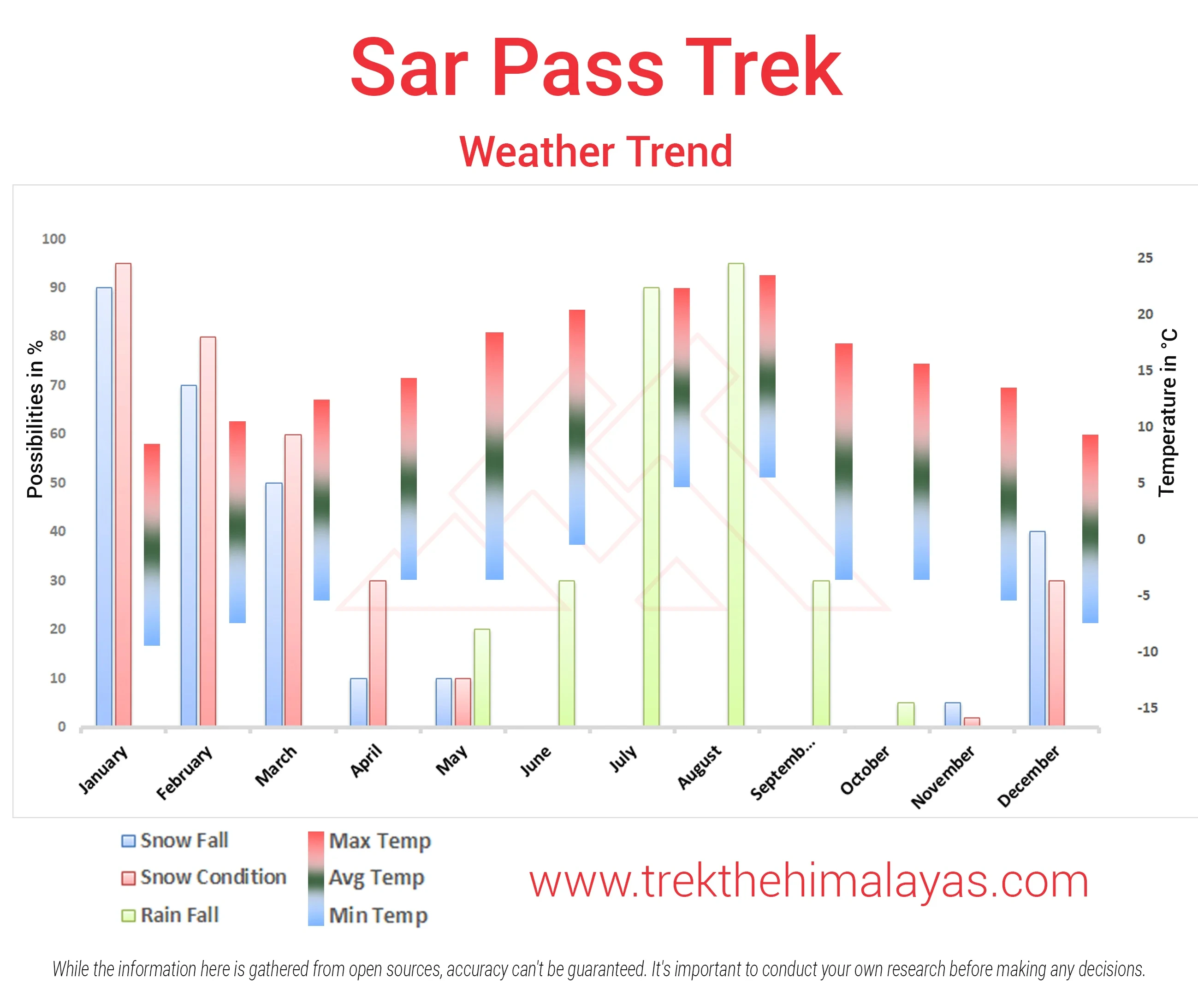
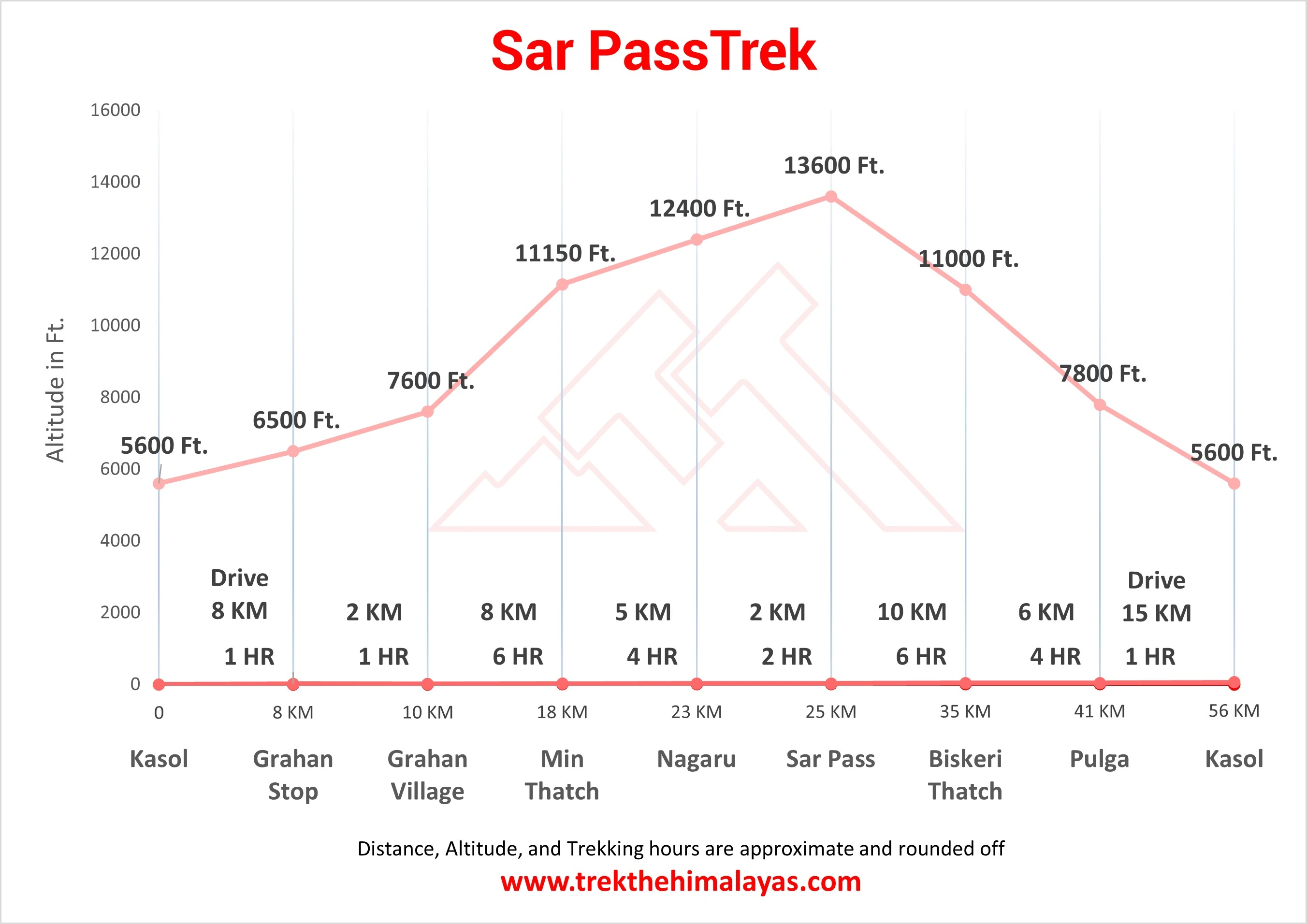
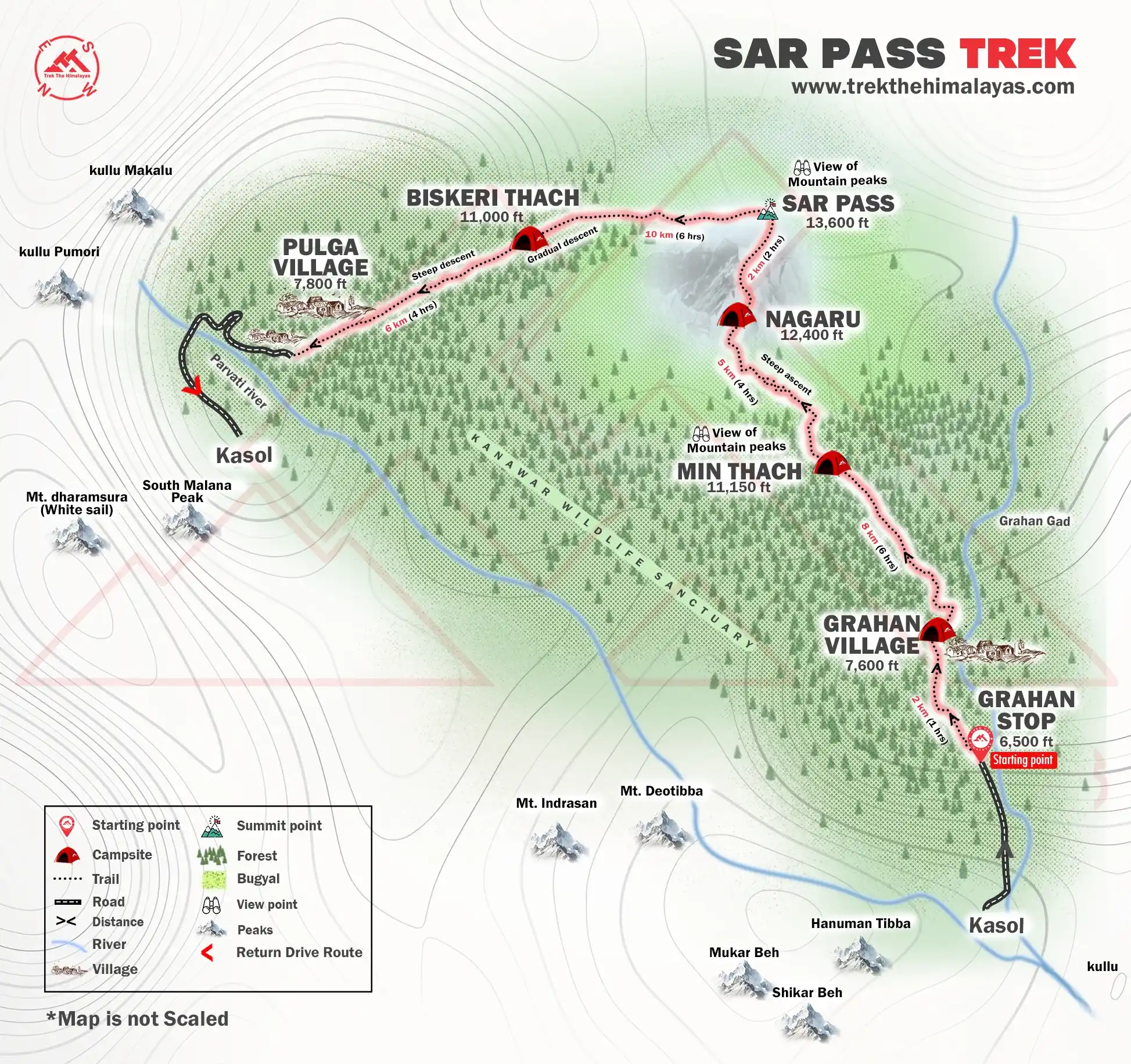
- Pulse rate at rest must be in between (60 to 100 beats per minute).
- Blood Pressure Reading must be in between (DIASTOLIC 75 – 85, SYSTOLIC 100 - 130 mm Hg).
- Respiratory rate at rest must be in between (12 to 20 breaths per minute).
- Should not have Liver and kidney issues.
- Should not have Diabetes Mellitus, Bronchial Asthma, Heart problems, Hypertension, etc.
- No pacemaker implant.
- People with Sinus issues, Epilepsy please contact to trek coordinator before booking the trek.
- If your BMI is not normal, Please contact our Trek coordinator before Trek booking.
Medical & Disclaimer Form (Mandatory Documents) Click here to download Medical & Disclaimer Form
Government employees can avail the benefit of Special Casual Leave (SCL) when they join us for a trekking expedition. As per Pay Commission guidelines, up to 30 days of Special Casual Leave can be availed in a calendar year for trekking or mountaineering expeditions conducted through a registered organisation.
Trek The Himalayas is a registered adventure tour operator with the Indian Mountaineering Foundation (IMF) and the Ministry of Tourism (MoT), making your trek eligible for SCL benefits.
To apply, email us at info@trekthehimalayas at least 20 days before the trek departure date, with the following details:
- Trek name and trek date
- Booking details
- Full name
- Designation
- Department and department address
This benefit is exclusive to Indian Government employees and is applicable only for treks within India.
- Junior trekkers (below 15 years) should have a company of parents/guardians.
- Trekkers between 15 to 18 years can come solo with the disclaimer form signed by parent/guardian.
- Medical & Disclaimer Form (Mandatory Documents) Click here to download Medical & Disclaimer Form
Important Links
- Mandatory Documents to Bring on A Trek Click Here.
- How to pay Add-ons, Submit Medical Forms, and Dietary Preferences Click Here to watch Video
How To Reach
It is essential for everyone to arrive at Kasol (11:00 am)
Once you have reached the assembly point of the trek in Kasol, TTH will manage the rest of your travel arrangements, if you have opted for TTH's pick-up service, you can select this option during the booking process by adding it as an add-on.
Options to reach Kasol
1. Take overnight bus to Kasol from Delhi or Chandigarh.
-Chandigarh to Kasol Bus: 10 hours.
-Delhi to Kasol Bus: 14 hours.
2. Take overnight bus to Kullu and then private taxi / shuttle bus service to Kasol
We always recommend going for the govt. Buses over the private ones outside the bus station as based on the experience we have found that there are very high chances of delay involved with private buses. Also, govt. Buses are always more reliable. Whichever bus you choose, just make sure to reach Kasol at 9 am positively.
3. You can take a flight to Bhuntar Airport (but we would not recommend it because of the high prices of the flight and very high chances of cancellations), Kasol is just a couple of hours away and you can easily get a bus or a private taxi till there. If you do plan to come via Bhuntar, make sure to reach at least a day before the trek starts.
4. You can even come via train, Pathankot railway station is from where you can get direct buses to Kullu/Kasol that is 300 km from there and would take an overnight journey. Even in this case, reach a day before at Kasol.
Taking a flight to Chandigarh Airport and then travelling by bus to Kasol is the best option.
( If you prefer to travel independently, you can either take a government bus or book a private cab. Your trek coordinator will provide guidance on how to arrange for the bus or cab booking. )
Trekkers will be dropped at Kasol in between 4 to 6 pm.
Taxi waiting charges will be applicable if want to visit Gurudwara Sahib Manikaran and hot spring.
TTH offers comfortable transportation through Tempo Traveler, Bolero, or equivalent vehicles. If you wish to upgrade your mode of transportation, please contact your trek coordinator for further assistance.
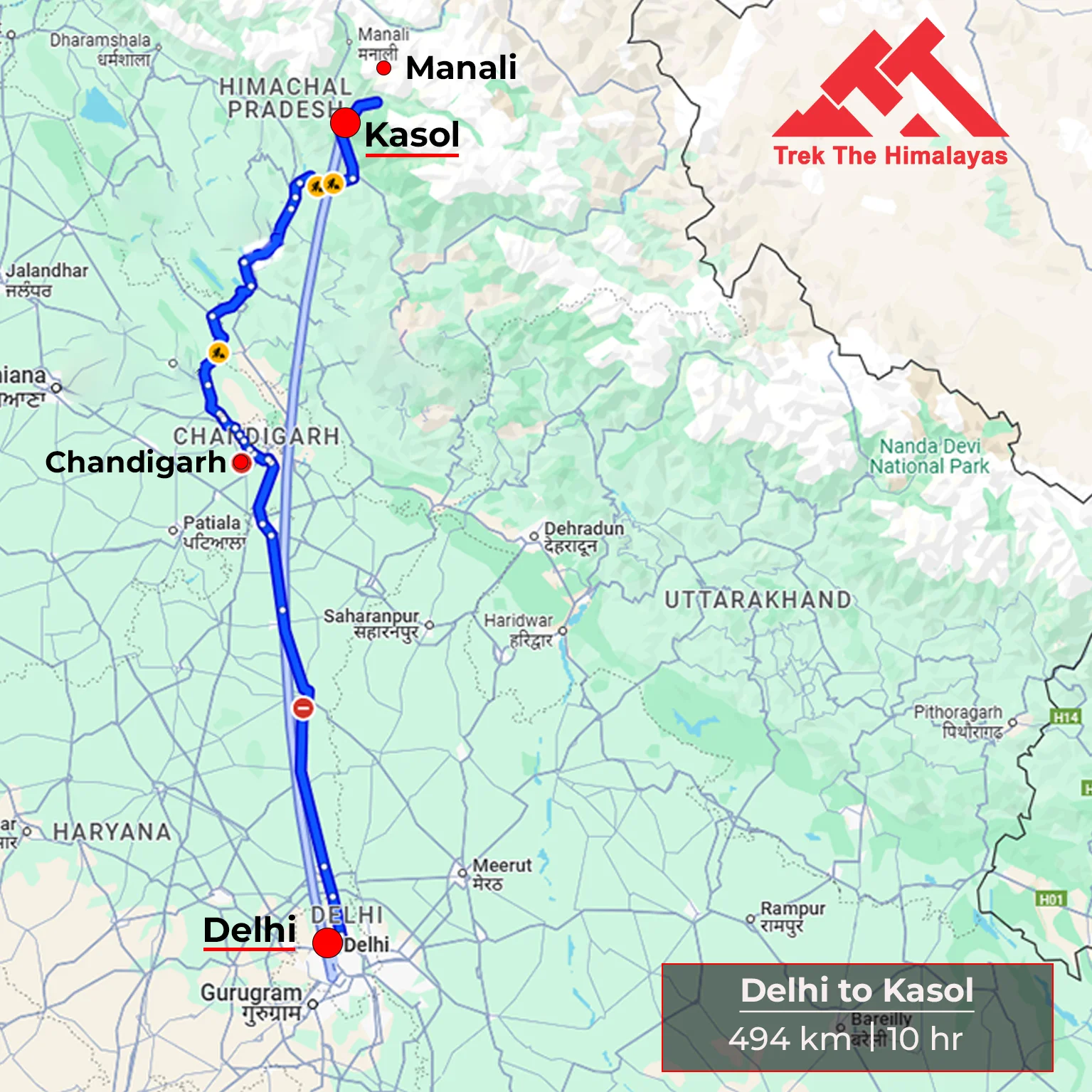
Cost Terms
Inclusion
1.Accommodation (as per the itinerary):
- Camping on Day 1 to Day 4
2.Meals (Veg + Egg):
- From the Day 1 Lunch to the Day 5 Lunch
3.Support:
- 1 Versatile base camp manager: handles communication and deploys extra manpower in emergencies.
- 1 Mountaineering & First aid qualified professional expedition Leader.
- 1 Experienced high altitude chef.
- Local experienced guides (Number of guides depending on the group size).
- Enough support staff.
4.Trek equipment:
- Sleeping bag, Sleeping liners (if required), Mattress, Utensils.
- 3 men all season trekker tent (twin sharing), Kitchen & Dining tent, Toilet tent.
- Camping stool, Walkie talkie.
- Ropes, Helmet, Ice axe, Harness(if required).
- Climbing Boots, Gaiters & Crampon /micro spike (if required).
5.First aid:
- Medical kit, Stretcher, Oxygen cylinder, Blood pressure monitor, Oximeter, Stethoscope.
6.Cloakroom service at base camp.
7. Mules/porters to carry the central luggage.
8. All necessary permits and entry fees, up to the amount charged for Indians.
9. Insurance ( Only for Indian Trekkers)(Additional charges apply for Non-Indian trekkers ).
10. Trek Completion Certificate.
Exclusion
- Insurance (For non-Indian Nationals, NRI or OCI card holders).
- Food during the transit.
- Any kind of personal expenses.
- Mule or porter to carry personal luggage.
- Emergency evacuation, hospitalization charge, etc.
- Any extra costs incurred due to extension/change of the itinerary due to natural calamities roadblocks, vehicle breakdown, etc. factors beyond our control
- Transportation Kasol to Kasol
- Anything not specifically mentioned under the head Inclusion.
Things can be provided on demand and availability (participant has to pay extra for these things).
- is a type of mobile phone that connects via radio links via satellites orbiting the Earth instead of terrestrial cell sites like cellphones. Therefore, they can operate in most geographic locations on the Earth's surface.
2- Gamow/PAC HAPO Bag (Portable Hyperbaric Bag) - is a unique, portable hyperbaric chamber for the treatment of acute mountain sickness (AMS), also known as altitude sickness.
3- AEDs (Automated External Defibrillators) -are portable life-saving devices des igned to treat people experiencing sudden cardiac arrest, a medical condition in which the heart stops beating suddenly and unexpectedly.
Cancellation Terms
To request a cancellation, please email us at info@trekthehimalayas.com using your registered email ID.
Cancellations prior to 25 days from the start of the Trip
Refund Options
- 5% deduction of trek fee
- 100% trek fee cash voucher for any trip till one year
- Transfer your trek (any trek, any date) to your friend
Cancellation between 24 days and 15 days to the start of the Trip
Refund Options
- 30% deduction of trek fee
- 100% trek fee cash voucher for same trip till one year
- 85% trek fee cash voucher for any trip till one year
- Transfer your trek (same trek, any date) to your friend
Cancellation between 14 days and 10 days to the start of the Trip
Refund Options
- 50% deduction of trek fee
- 80% trek fee cash voucher for same trip till one year
- 70% trek fee cash voucher for any trip till one year
- Book the same trek, in the same season, with any other batch
- Transfer your trek (same trek, any date) to your friend
Cancellation less than 9 days to the start of the trek.
Refund Options
- No cash refund
- 20% trek fee cash voucher for the same trip till one year
- 10% trek fee cash voucher for any trip till one year
- Transfer your trek (same trek, same date) to your friend
- To reschedule a trek (same trek only), a 30 % rescheduling fee of the trek cost will apply.
Cancellation Policy (Emergency Cases):
In case of a death in the immediate family (parents, siblings, spouse, children) or if the trekker is hospitalized (min. 48 hours) or suffers a fracture (leg/arm) within a week before the trek, even if canceled a day before:
90% trek fee refund in cash & 10% as a voucher (valid for 1 year, for any India trek).
Valid documents required. We’re here to support you during tough times.
Note:
- Change of trek batch is dependent on the availability of seats in the batch
- In case of transferring a trek to a friend, he/she should satisfy all the mandatory requirements put forward by TTH
- TTH holds the right to change/cancel the policies, without prior notice
Booking and Payments
- The Participant is responsible for verifying the accuracy of all details, including Trip dates and personal documentation, at the time of booking.
- Payments must be made in accordance with the timelines and instructions provided by TTH. Late payments may result in cancellation of booking without refund.
- In the event of a cash refund, only the portion of the payment made in cash shall be eligible for refund in cash. Any booking made using voucher, discounts, promotional codes, or through any non-cash mode of payment shall not be eligible for a cash refund under any circumstances.
- Refunds, if applicable, shall be processed within 15–30 working days of confirmation.
- All add-on bookings are subject to the respective add-on cancellation policy, and refunds will be processed accordingly.
- Voucher Terms
- This is a non-transferable voucher
- The voucher cannot be merged with any other offer of Trek The Himalayas
- The voucher is valid for Trek booked directly with Trek The Himalayas in India
- To avail the voucher please use your register phone number or e-mail id
- All the other Terms of booking a trek with Trek The Himalayas are applicable to the voucher
Itinerary and Modifications
- TTH reserves the right to modify, shorten, or cancel any part of the Trip due to transportation delays, weather, health emergencies, or other unforeseen circumstances including Force Majeure.
Cancellations and Refunds
- No refunds or vouchers, partial or otherwise, shall be provided for voluntary withdrawal, non-utilisation of services, or removal from the Trip.
- If TTH cancels the Trip before arrival at the designated pick-up point due to unforeseen circumstances or Force Majeure, the Participant may choose from:
- An alternate Trip/date.
- A credit voucher valid for one (1) year.
- Transfer to another Trip, with cost differences payable by the Participant.
- If the Trip is abandoned post-arrival at the designated pick-up point, no cash refund or voucher shall be issued. The Trek Again Policy may apply at TTH’s discretion.
- TTH shall not be liable for any associated travel costs such as flights, accommodation, or visa fees.
Force Majeure
- Events beyond its control including but not limited to earthquakes, landslides, strikes, curfews, war, pandemic, government restrictions, heavy rainfall or snowfall, windstorms, road blockages, trail disruption, or withdrawal of permits, TTH shall not be held liable for any cancellation, delay, or service modification caused by Force Majeure.
Trek Essentials
Rent EquipmentPDF Of Trek Essential Download
| Backpack with rain cover | (50 - 60 ltr) with comfortable shoulder straps |
| Day pack with rain cover | 20 - 30 ltr (If off-load opted) |
| Walking stick | Advisable (At least one) |
| Water Bottle / Hydration pack | 2 bottles of one liter each, People who use hydration pack 1 hydration pack and 1 bottle of one liter. |
| Small size tiffin/lunch box | 1 Nos |
| Snacks | Energy bars, dry fruits, electral/ors |
| Personal Medical Kit | Consult your doctor |
| T-Shirt (Synthetic quick dry) | 2 Full & 2 Half sleeves |
| Fleece T-shirt | 1 Nos |
| Wind stopper / Fleece jacket | 1 Nos |
| Windproof Jacket | 1 Nos |
| Down feather / Hollow jacket | 1 Nos |
| Thermal inner (Upper and Lower) | 1 Pair |
| Trek Pant (Synthetic quick dry) | 3 Nos |
| Wind stopper / Fleece Pant | Not required |
| Waterproof gloves | Not required |
| Fleece / woollen gloves | 1 Pair |
| Poncho / waterproof Jacket and pant | 1 Nos |
| Sunscreen | 1 Nos |
| Moisturiser | 1 Nos |
| Chap-stick / Lip balm | 1 Nos |
| Toothbrush and toothpaste | 1 Nos |
| Toilet paper & Wipes | 1 Nos |
| Soap / hand sanitizers | 1 Nos |
| Antibacterial powder | 1 Nos |
| Quick dry towel | 1 Nos |
| Head torch | 1 Nos. (Avoid Hand torch) |
| Sun Cap | Not required |
| Woolen cap | 1 Nos. |
| Balaclava | Not required |
| Buff / Neck-gaiters | 2 Synthetic |
| Sunglasses | UV with dark side cover, People who wear spectacles - (A)- Use contact lenses | (B)- Photo chromatic glasses |
| Trekking shoes | 1 Pair (Water-resistant, high ankle, good grip) |
| Floaters / flip-flops | 1 Pair |
| Cotton socks | 7 pairs |
| Woollen socks | 1 pairs |
| Gaiters | 1 Pair (TTH provides when required) |
| Micro spikes | 1 Pair (TTH provides when required) |
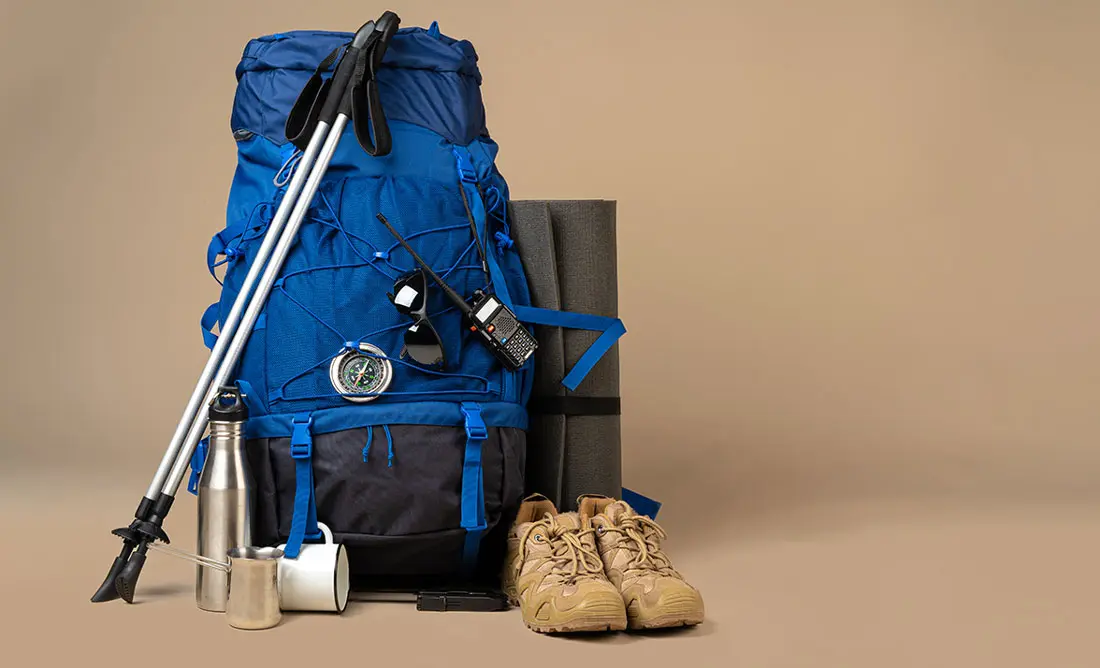
Frequently Asked Questions(FAQ)
To register with TTH, visit our website - www.trekthehimalayas.com and create your account. To create your account you will need to use your email address and fill in all the details, set your unique password and your account is ready to use.
- To book a trek with TTH, you first need to register with us and create an account.
- Choose the trek that you want to do and click on available dates.
- You will land at the login page, fill in the required details.
- Add Participants, choose add-on services click on the Pay now button, choose your preferred payment method, and make the payment. TTH accepts multiple payment options, including credit/debit cards, net banking, and UPI.
- You will receive a confirmation email from TTH with all the necessary details about the trek, including the meeting point, transportation, accommodation, and other important instructions.
- Click Here to watch Video
please send an email to us at info@trekthehimalayas.com or reach out to the numbers provided in the Help and Support section of your Trek Page. We will ensure that your issue is promptly resolved.
To book services such as off-load luggage and transportation, you can find them listed as add-ons. These additional services can be booked at the time of your initial booking. If you miss booking add-ons during the initial reservation, you can log in anytime and easily book 4 days before the departure date add-ons through the platform.
If you have booked the wrong trek or selected the wrong date, don’t worry! You can contact us at +91 9368882322 (Monday to Saturday, 10 AM to 10 PM) or email us at info@trekthehimalayas.com. You can also discuss this with your trek coordinator. Please make sure to inform us at least 10 days before the departure of your trek. Only then can we help you reschedule or arrange another trek for you.
We recommend visiting our "Suggest Me a Trek" page. By filling out the form, our experts will contact you with the best possible trek options based on your preferences and experience level. Alternatively, you can reach out to us via email at info@trekthehimalayas.com or give us a call using the numbers provided on our website for personalized assistance and recommendations.
Family treks differ from regular treks by focusing on ease of difficulty, offering shorter durations for younger participants, Kid-friendly and easily digestible foods, child-friendly activities, maintaining a higher guide ratio for diverse age groups, and implementing additional safety measures for families.
Family Trek with Kids recommendation Only Dayara Bugyal and Chopta Chandrashila Trek.
Minimum age for TTH treks is typically 7 years, though this may vary depending on the specific trek.
Yes, you can take a kids to a high-altitude trek with a parent. Discuss with a trek expert before booking a trek.
- Junior trekkers (below 15 years) should have a company of parents/guardians.
- Trekkers between 15 to 18 years can come solo with the disclaimer form signed by parent/guardian.
- Medical & Disclaimer Form (Mandatory Documents) Click here to download medical and disclaimer form
Physical Fitness: Ensure your child is physically fit. Engage them in regular exercise, outdoor activities, and hikes to build stamina and endurance. Hydration: Emphasize the importance of staying hydrated at high altitudes. Encourage your child to drink water regularly, even if they don't feel thirsty. Proper Nutrition: Provide a well-balanced diet with sufficient carbohydrates for energy and foods rich in iron to prevent altitude sickness. Adequate Sleep: Ensure your child gets enough sleep in the days leading up to the trek. Quality rest is crucial for altitude adaptation. Educate on Altitude Sickness: Teach your child about the symptoms of altitude sickness, such as headache, nausea, and dizziness. Encourage them to communicate any discomfort immediately. Appropriate Clothing and Gear: Dress your child in layers to adjust to changing temperatures. Ensure they have appropriate trekking gear, including sturdy footwear. Positive Mindset: Foster a positive mindset. Encourage your child, and let them know it's okay to take breaks when needed. Medical Check-Up: Schedule a medical check-up before the trek to ensure your child is fit for high-altitude activities. Consult with a healthcare professional about any potential health concerns.
TTH takes special care to provide wholesome and nutritious food for children on treks. Here are some of the foods that are typically served for children:
Breakfast: For breakfast, TTH serves a variety of options like porridge, cornflakes, bread, butter, jam, honey, boiled eggs, omelettes, and pancakes. Children can choose from these options to fuel themselves for the day's trek.
Lunch: For lunch, TTH serves lunch which includes rotis, vegetables, rice, dal, and salad. The rotis are usually made fresh on the trek and are a good source of carbohydrates. The dal and vegetables provide protein and other essential nutrients.
Snacks: TTH provides healthy snacks like fresh fruits, dry fruits, energy bars, cookies, and biscuits to keep the children energized throughout the day.
Dinner: For dinner, TTH serves a hot and wholesome meal which includes soup, rice, dal, vegetables, and a non-vegetarian dish (if requested in advance). Children can also choose from a variety of desserts like custard, jelly, and fruit salad.
Dietary requirements: If a child has any special dietary requirements, TTH can cater to those needs as well. For example, if a child is lactose intolerant or allergic to nuts, the kitchen staff can make arrangements to accommodate those requirements.
Choosing the right trek for a beginner can be a bit overwhelming as there are many factors to consider such as distance, elevation gain, terrain difficulty, weather, and time of year. Here are some tips that can help you choose the right trek for a beginner:
1. Determine fitness level: Assess the fitness level of the beginner to understand their physical capabilities. This will help you select a trek that is challenging but not too difficult.
2. Choose a well-traveled trail: A well-traveled trail will have more amenities such as signposts, water stations, and shelter. It is also safer as there will be other hikers on the trail.
3. Consider the length of the trek: For beginners, it is recommended to start with a shorter trek that can be completed in a day or two. This will help them get acclimatized to trekking and build their confidence.
4. Look for gradual elevation gain: Choose a trek with a gradual elevation gain rather than steep ascents. This will make the trek easier and more enjoyable.
5. Check the weather: Check the weather forecast before selecting a trek. Avoid treks during the monsoon season or winter when the trails can be slippery or dangerous.
6. Research the trail: Read about the trail to get an idea of the terrain, altitude, and difficulty level. This will help you select a trek that is suitable for the beginner.
7. Consult with an expert: If you are unsure about which trek to choose, consult our trek expert Mr. Nitin (+91 70600 59773) between 10 AM to 6 PM (Tuesday - Friday). Mr. Nitin will provide you valuable advice and guidance.
Overall, it is important to choose a trek that is enjoyable, challenging but not too difficult, and suitable for the beginner's fitness level and experience.
It is not recommended for a beginner to choose a difficult Himalayan trek. Trekking in the Himalayas can be physically and mentally challenging, especially if you are not used to the high altitude, steep slopes, and rugged terrain. Choosing a difficult trek without the proper experience, fitness level, and preparation can be dangerous and put you at risk of altitude sickness, injury, and other hazards.
If you are a beginner, it is recommended to start with an easier trek and gradually build up your skills and experience. This will help you understand the challenges of trekking in the Himalayas, and also prepare you physically and mentally for a more difficult trek in the future. It is also important to choose a trek that matches your fitness level, experience, and interest.
There is no specific age limit for a beginner trekker. However, it is important to consider your physical fitness, health condition, and personal interests before embarking on a trek. Trekking in the Himalayas can be physically and mentally demanding, and requires a certain level of physical fitness and endurance.
If you have any pre-existing medical conditions or are above a certain age, it is recommended to consult with a doctor before embarking on a trek. It is also important to listen to your body and take breaks as needed during the trek to prevent exhaustion or injury.
We recommend visiting our "Suggest Me a Trek" page. By filling out the form, our experts will contact you with the best possible trek options based on your preferences and experience level. Alternatively, you can reach out to us via email at info@trekthehimalayas.com or give us a call using the numbers provided on our website for personalized assistance and recommendations.
Yes, you can join the trek. We have fixed departure groups where you can simply book your trek and we will take care of curating a group.
Before you start the trek, it is recommended that you make all the necessary phone calls as during the trek you may or may not receive network coverage, once you come back to the Base Camp, you can reconnect with your family via phone once again. You can share your trek coordinator contact detail with your family members to get the latest updates about your trek batch.
At TTH, we provide wholesome and nutritious meals during the trek. The food is vegetarian and includes a variety of dishes such as rice, dal, vegetables, chapati, paratha, pasta, noodles, and soup. We also offer snacks such as biscuits, and salty, and dry fruits during the trek. Special dietary requirements such as vegan, gluten-free, or Jain food can also be arranged if informed in advance.
If you are allergic to some foods, you need to let us know in advance so that we can make arrangements accordingly.
TTH is a trekking company that prioritizes the safety of all its participants, including women trekkers. We have a comprehensive safety system in place, which includes a dedicated team of experienced and trained trek leaders and support staff who are equipped to handle emergency situations and provide first aid.
TTH also takes specific measures to ensure the safety and comfort of women trekkers. They have a separate tent accommodation for women trekkers, female trek leaders, and support staff. They also provide separate toilet facilities for women and encourage a safe and respectful environment for all trekkers.
Moreover, TTH has a strict policy against any kind of harassment and has a zero-tolerance policy towards such incidents. They have a designated Internal Complaints Committee (ICC) to investigate and address any complaints related to harassment or misconduct. Overall, TTH has a good reputation for safety and responsible trekking practices, and women can feel comfortable and safe while trekking with them.
In case you are the only women in the group, we provide a single sleeping arrangement. Also, during the trek, the trek leader will always remain by your side to provide optimum safety and reassurance.
You can reach out to the trek coordinator to inquire about the number of female trekkers and their respective states who have booked the trek. Please note that the trek coordinator cannot disclose personal details of any trekker. Once you've confirmed your booking, a WhatsApp Group will be created for all the trekkers in your batch. This allows you to connect with fellow trekkers before the trek begins.
While many of our treks are led by female trek leaders, however, it is not possible to know which trek leader is assigned to which group. But nonetheless, whether the trek leader is male or female you can be completely assured of your safety and security with us.
Yes, it is possible to trek with periods. However, it is important to take some extra precautions and preparations to ensure a comfortable and safe trekking experience. Here are some tips that can help you trek during your period:
1. Use menstrual hygiene products that you are comfortable with, such as tampons, pads, or menstrual cups. It is recommended to carry enough supplies for the entire duration of the trek.
2. Pack wet wipes, hand sanitizer, and plastic bags to dispose of used hygiene products.
3. Wear comfortable and breathable clothing that allows for easy movement and reduces friction. Avoid wearing tight or restrictive clothing that can cause discomfort.
4. Carry pain relief medication, such as ibuprofen or acetaminophen, in case of menstrual cramps.
5. Stay hydrated and maintain a balanced diet to support your energy levels and overall health.
6. Take breaks as needed and listen to your body. If you feel uncomfortable or experience any unusual symptoms, seek medical attention immediately. It is also recommended to consult with a doctor before going on a trek during your period, especially if you have a pre-existing medical condition or are taking medication.
By taking necessary precautions and being prepared, you can have a safe and comfortable trekking experience even during your period. We provide proper disposal facilities for sanitary pad disposal during the trek.
We offer three person tents with twin-sharing for optimum comfort. A woman trekker will share a tent with another woman trekker and if you are the only woman in the group, you will be given a single accommodation for your comfort and privacy.
Yes, we do provide gears on rent. You can book it using you TTH account directly.
Mountaineering qualified Experienced and first aid certified Trek Leader, First Aid Certify local guide, Cook, helpers and supporting staff.
People suffering from Bronchitis, Asthma, High blood pressure, Epilepsy (got faints), TB , Heart problem or on higher BMI side are strictly not allowed to go on any Himalayan trek. Apart from this if you had any medical history, please let us know.
No. Alcohol and smoking isn’t allowed while on trek. It is totally misconception that it will keep you warm. Your body need to acclimatize properly and for that eat properly and drink enough water; these things will keep you warm.
Toilet tents provide a convenient solution for answering nature's call in the great outdoors. Dry toilets, in particular, offer a highly sanitary approach. By digging a pit and utilizing mud and a shovel, you can easily cover up your waste. This method ensures cleanliness and hygiene while camping or exploring in the forest.
Remember to pack essential toiletries to complete your outdoor bathroom kit and maintain proper personal hygiene during your adventures. With these practices in place, you can enjoy nature while also respecting it.
Layer Up From Head To Toe
Eat Full Meals, never sleep empty stomach
You can keep warmee (if you’re more susceptible to cold).
Use sleeping bag in right way and don’t leave free space in sleeping bag.
For upper body
– Thermal layer
– T-shirt (full-sleeves)
– Fleece T-shirt (for extreme colds)
– Fleece layer
– Thick Jacket/Down Jacket
– Waterproof or Windproof layer (outermost layer, when it is snowing or raining)
- For Lower Body
– Thermal layer
– Hiking pants (normal) or Winter hiking pants
Based on how warm you feel you can skip any of the above layers. Your outer later should be windproof since it is windy at high altitude.
The idea behind layering is that the more insulation you have the less cold you feel, and instead of wearing a very thick jacket if you wear multiple layers, your body will be better insulated against the cold.
Yes, we provide micro spikes and gaiters, if required.
Mandatory documents: 2 xerox of ID having address (addhar card/driving license), 2 Passport size photographs, hard copy Medical form signed & sealed by doctor, disclaimer form sign by trekker and high altitude insurance.
No. We don’t but we can suggest you good hotel/Stay nearby pick up location.
Yes, trekker must carry 2 water bottles 1 litre each so they can refill it at campsite for drinking and keep themselves hydrate.
You should buy shoes which has these three features –Good grip, Ankle Support and additional water resistant layers. Generally, we advise Quechua Trek 100, MH 500 and MH 100.
No one is forced to go on. There is always enough staff to split the party according to need and regroup later at the camp. Most people have no trouble reaching the highest campsite. If some members decide not to climb the final distance they can wait for the climbers to come back down the same way or take a lateral path to the descent route.
Here are some of the essentials you should carry for the trek:
1. Trekking shoes: A good pair of trekking shoes is essential for a comfortable trek. Make sure your shoes are well-fitted, sturdy, and provide good grip on the trail.
2. Warm Clothing: The weather can be unpredictable in the mountains, so it's important to carry warm clothing, including thermal innerwear, fleece jackets, down jacket, and waterproof jackets.
3. Trekking pants: Carry comfortable and quick-drying trekking pants that are suitable for weather conditions.
4. Backpack: A good quality backpack with a capacity of 40-50 liters is ideal for carrying your essentials during the trek.
5. Sleeping bag: A good quality sleeping bag is essential for a comfortable stay during camping nights.
6. Headlamp/Flashlight: Carry a good quality headlamp or flashlight with extra batteries for trekking during early morning or late evening hours.
7. Water bottle: Carry a reusable water bottle and stay hydrated throughout the trek.
8. Snacks: Carry energy bars, dry fruits, and snacks for instant energy during the trek.
9. First aid kit: Carry a basic first aid kit, including band-aids, antiseptic cream, pain relief spray, and medicines for altitude sickness.
10. Sun protection: Carry sunscreen lotion, sunglasses, and a hat to protect yourself from the harsh sun rays.
11. Trekking poles: Trekking poles can help in maintaining balance and reduce the strain on your knees while trekking.
Sar Pass is a beautiful Himalayan trek located in Himachal Pradesh, beginning from the charming village of Kasol. This trek offers a perfect blend of lush green valleys and pristine white snow-covered landscapes, giving you a glimpse of the untouched beauty of the Himalayas. As you make your way through the stunning Parvati Valley, the trail takes you across remote mountain villages, dense forests of pine and oak, and towering snow-capped peaks. Along the way, you’ll get a chance to experience the local culture, interact with the warm and welcoming villagers, and witness their traditional way of life.
The best time to do the Sar Pass Trek is during the summer months, from mid-April to June. During this period, the weather is pleasant and stable, with clear skies and moderate temperatures, making trekking conditions ideal. The trails are at their most scenic, with lush green meadows, blooming wildflowers, and snow-covered peaks in the distance. By May and June, the higher sections of the trek are still covered in snow, offering a stunning contrast between greenery and white landscapes. Monsoon season (July-August) brings heavy rainfall, making the trails slippery and risky, while winters (October-March) cover the entire region in deep snow, making trekking difficult. Therefore, April to June is the perfect window to experience the beauty, adventure, and thrill of the Sar Pass Trek at its best.
The Sar Pass trek package of Trek the Himalayas includes accommodations, meals, trek equipment, first aid and support staff including local experienced guides, base camp manager and professional trek leader.
The maximum altitude of Sar Pass Trek is 13,800 feet. You will reach this impressive height when you arrive at Sar Pass, the highest point of the trek. From the top, you will be rewarded with breathtaking panoramic views of the snow-covered Himalayas, with majestic peaks stretching endlessly into the horizon. The scenery includes lush valleys below, deep forests in the distance, and a vast expanse of white snow all around. The feeling of standing at this altitude, surrounded by nature’s raw beauty, is truly unforgettable.
The Sar Pass Trek covers a total trekking distance of approximately 50 km. During this journey, you will trek through dense pine and oak forests, vibrant meadows filled with wildflowers, and challenging snowy terrains. The trails vary from gentle slopes to steep ascents, keeping the trek exciting and rewarding. As you walk through scenic villages, high-altitude campsites, and breathtaking landscapes, every step brings a new and beautiful view. The combination of forests, meadows, and snow-covered paths makes this trek an enriching experience.
Yes, the Sar Pass Trek is safe, especially when done with an experienced trekking organization. However, it is important to take necessary precautions and follow the safety guidelines given by trek leaders and guides. The trail includes steep climbs, slippery snow patches, and narrow ridges, so proper guidance is essential. Staying with your group, keeping a steady pace, and following instructions will help ensure a smooth and safe trekking experience.
The Sar Pass Trek is considered a moderate grade trek, and having prior trekking experience is recommended. The trail involves steep inclines, rocky paths, and unpredictable weather conditions, which can be challenging for beginners. A good fitness level and mental preparedness are necessary to complete the trek comfortably. However, with proper training, basic fitness exercises, and guidance from experienced trek leaders, even first-time trekkers can successfully complete Sar Pass. The key is to be well-prepared, carry the right gear, and maintain a positive mindset throughout the journey.
During the Sar Pass Trek, you will stay in a guest house in the base camp and on the slopes you will be staying in tents (twin-sharing).
The Sar Pass Trek starts from Kasol, a charming village nestled in the heart of Parvati Valley. Known as a backpacker’s paradise, Kasol is famous for its scenic beauty, peaceful atmosphere, and vibrant culture. The village is surrounded by lush green forests, towering mountains, and the soothing Parvati River, making it an ideal starting point for an adventure.
Parvati Valley itself is a picturesque region in Himachal Pradesh, known for its breathtaking landscapes, quaint villages, and spiritual significance. The valley is home to dense pine forests, rolling meadows, and snow-covered peaks. Trekkers often spend time in Kasol before starting their journey, exploring its cozy cafes, riverside trails, and warm hospitality.
The best Himachal Pradesh Treks include Buran Ghati, Hampta Pass, Bhrigu Lake, Rupin pass and Friendship peak.
The highlight of the trek is Sar Pass, a high-altitude mountain pass that challenges trekkers with steep ascents and snow-covered trails, offering a thrilling yet rewarding experience. As you navigate the terrain, the breathtaking Himalayan views keep you motivated. The trek takes you through scenic campsites, lush meadows, dense forests, and snowy slopes, each adding to the adventure. The crisp mountain air and serene surroundings make every step unforgettable. Reaching the summit of Sar Pass is a moment of pure triumph, rewarding you with panoramic views of endless snow-capped peaks and valleys. Along with being an adventurous trek, Sar Pass is a journey of self-discovery, pushing you beyond your limits while immersing you in the grandeur of nature. Whether you seek challenge, peace, or connection, this trek offers an unforgettable experience, leaving you with memories that will last a lifetime.
Yes, a person over 50 can definitely do the Sar Pass trek, but it’s important to have a good level of physical and mental fitness. The trek involves long walking hours, steep ascents, and high-altitude conditions, so prior preparation is essential. Regular walking, cardio exercises, and strength training can help improve stamina.
Additionally, mental endurance plays a key role, as trekking through varying terrains and unpredictable weather requires determination and adaptability. Consulting a doctor before the trek is advisable, especially for those with pre-existing health conditions.
The Sar Pass Trek stretches about 33 kilometers and is completed over 5 days.
The Sar Pass trek starts from the scenic Grahan village and takes you through beautiful campsites like Min Thatch and Nagaru before reaching the stunning Sar Pass. From there, the trail continues to the lush meadows of Biskeri Thach. After enjoying the stunning views at Biskeri Thach, you will trek down to Pulga, from where a drive will take you back to Kasol, marking the end of this incredible journey.
The Sar Pass Trek covers a total trekking distance of approximately 50 km. During this journey, you will trek through dense pine and oak forests, vibrant meadows filled with wildflowers, and challenging snowy terrains. The trails vary from gentle slopes to steep ascents, keeping the trek exciting and rewarding. As you walk through scenic villages, high-altitude campsites, and breathtaking landscapes, every step brings a new and beautiful view. The combination of forests, meadows, and snow-covered paths makes this trek an enriching experience.
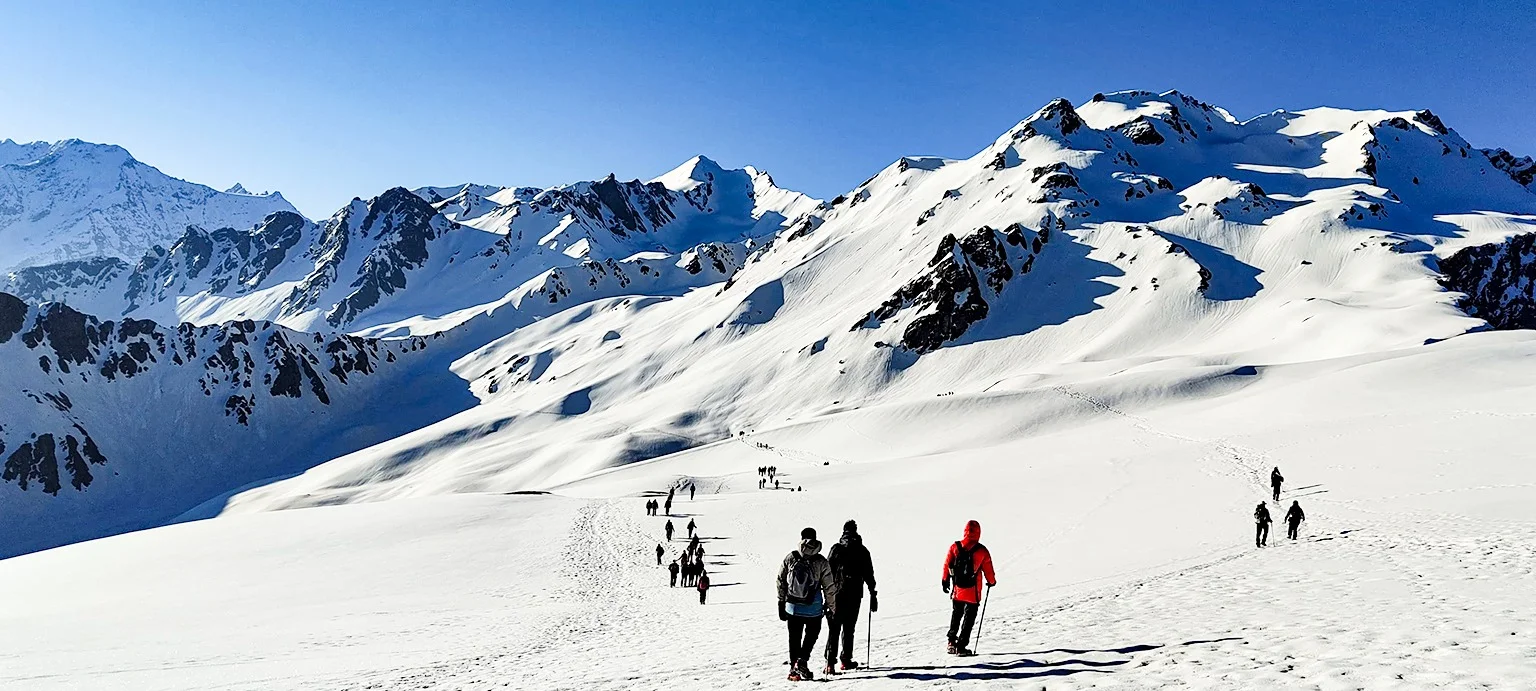
.webp)
.webp)
.webp)
.webp)
.webp)
.webp)
.webp)
.webp)
.webp)
.webp)
